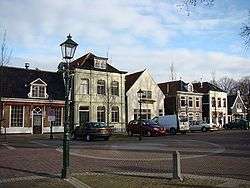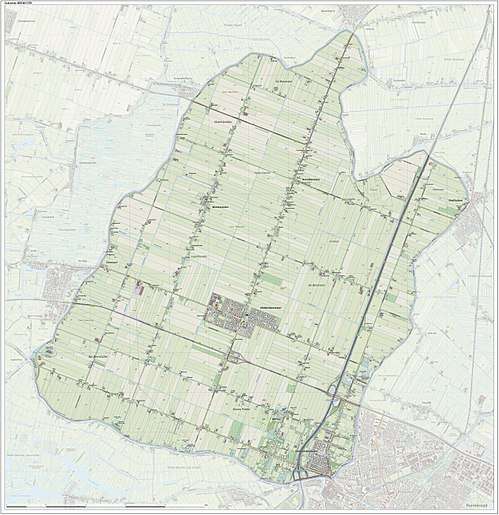Beemster
| Beemster | |||
|---|---|---|---|
| Municipality | |||
 Middenbeemster town centre | |||
| |||
.svg.png) Location in North Holland | |||
| Coordinates: 52°33′N 4°55′E / 52.550°N 4.917°ECoordinates: 52°33′N 4°55′E / 52.550°N 4.917°E | |||
| Country | Netherlands | ||
| Province | North Holland | ||
| Government[1] | |||
| • Body | Municipal council | ||
| • Mayor | Joyce van Beek (CDA) | ||
| Area[2] | |||
| • Total | 72.07 km2 (27.83 sq mi) | ||
| • Land | 70.58 km2 (27.25 sq mi) | ||
| • Water | 1.49 km2 (0.58 sq mi) | ||
| Elevation[3] | −4 m (−13 ft) | ||
| Population (August 2017)[4] | |||
| • Total | 9,386 | ||
| • Density | 133/km2 (340/sq mi) | ||
| Time zone | UTC+1 (CET) | ||
| • Summer (DST) | UTC+2 (CEST) | ||
| Postcode | 1460–1464 | ||
| Area code | 0299 | ||
| Website |
www | ||
| UNESCO World Heritage site | |||
| Official name | Droogmakerij de Beemster (Beemster Polder) | ||
| Criteria | Cultural: i, ii, iv | ||
| Reference | 899 | ||
| Inscription | 1999 (23rd Session) | ||
Beemster [ˈbeːmstər] (![]()
Population centres
The municipality of Beemster consists of the following cities, towns, villages and/or districts: Middenbeemster, Noordbeemster, Westbeemster, Zuidoostbeemster.
Topography

Topographic map of the municipality of Beemster, June 2015.
History
Around 800 AD the area of the modern municipality of Beemster was covered in peat. The name "Beemster" has been derived from "Bamestra" (see Groenedijk, 2000), the name of a small river in the area. In the period 1150-1250 peat-digging by people, and storm floods, enlarged that small river into an inland sea, a lake in open connection with the Zuiderzee. Around 1605 private investors started to drain the Beemster lake. In 1610, this was almost complete, but the lake re-filled because of a break in the Zuiderzee dikes. It was decided to make the ring-dike a meter high above the surrounding country. In 1612 the polder was dry and the country was divided among the investors. In the earlier days of the polder, farmers occupied its lands for growing the crops necessary for long sea journeys by the VOC to the East Indies. It turned out that the farmland was so good that the project was considered then to be an economic success, in contrast to e.g. the Heerhugowaard. Since 1999 the entire Beemster polder has been on the UNESCO world heritage list.
The Beemster polder is home to CONO Kaasmakers, maker of the Beemster brand of cheeses. This co-op was formed in 1901 to create cheese made from milk that comes from the Beemster polder. Today Beemster Cheese[5] is sold in Europe, as well as the U.S., Canada, Japan, and China.
World Heritage Site
Because of its historical relevance, and because the original structure of the area is still largely intact, the Beemster was inscribed on the UNESCO World Heritage Site list in 1999.[6] Justification for Inscription is as follows:
- Criterion (i): The Beemster Polder is a masterpiece of creative planning, in which the ideals of antiquity and the Renaissance were applied to the design of a reclaimed landscape.
- Criterion (ii): The innovative and intellectually imaginative landscape of the Beemster Polder had a profound and lasting impact on reclamation projects in Europe and beyond.
- Criterion (iv): The creation of the Beemster Polder marks a major step forward in the interrelationship between humankind and water at a crucial period of social and economic expansion.
In addition in the Beemster Polder there are five fortresses as part of the Stelling van Amsterdam, another UNESCO World Heritage Site. The Beemster Polder combines two UNESCO World Heritage Sites.
Local government
The municipal council of Beemster consists of 13 seats, which are divided as follows since 2014:
Mayor is Joyce van Beek (CDA).
See also
References
Footnotes
- ↑ "Harry Brinkman" (in Dutch). Gemeente Beemster. Retrieved 20 February 2014.
- ↑ "Kerncijfers wijken en buurten" [Key figures for neighbourhoods]. CBS Statline (in Dutch). CBS. 2 July 2013. Retrieved 12 March 2014.
- ↑ "Postcodetool for 1462NV". Actueel Hoogtebestand Nederland (in Dutch). Het Waterschapshuis. Retrieved 20 February 2014.
- ↑ "Bevolkingsontwikkeling; regio per maand" [Population growth; regions per month]. CBS Statline (in Dutch). CBS. 27 October 2017. Retrieved 27 October 2017.
- ↑ www.beemstercheese.us
- ↑ DK Eyewitness Travel Guide: The Netherlands: The Netherlands. DK Publishing. 1 August 2011. p. 175. ISBN 978-0-7566-8476-1.
Bibliography
- Van de Ven, G. (redactie) (1996). "Leefbaar laagland" (4th, revised reprint). Uitgeverij Matrijs. p. 33-35, 55 en 131-136.
- Groenedijk, T. (2000). "Nederlandse plaatsnamen". Slingenberg Boekproducties, Hoogeveen, Netherlands 2000.
External links

- Official website


